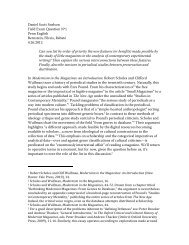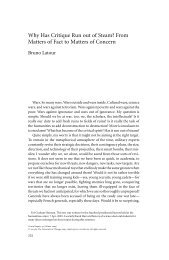The Exploit: A Theory of Networks - asounder
The Exploit: A Theory of Networks - asounder
The Exploit: A Theory of Networks - asounder
You also want an ePaper? Increase the reach of your titles
YUMPU automatically turns print PDFs into web optimized ePapers that Google loves.
14 Prolegomenon<br />
this book. “<strong>The</strong> novelty <strong>of</strong> the coming politics,” writes Giorgio Agamben<br />
on the topological nature <strong>of</strong> political struggle, “is that it will no<br />
longer be a struggle for the conquest or control <strong>of</strong> the State, but a<br />
struggle between the State and the non - State (humanity).” 4<br />
While the new American exceptionalism is at the forefront <strong>of</strong> our thoughts<br />
today, we would like to situate it within a larger context by making reference<br />
to three diagrams for political conflict, each finding its own historical actualization:<br />
a politics <strong>of</strong> symmetry rooted in opposed power blocs, a politics <strong>of</strong><br />
asymmetry in which power blocs struggle against insurgent networks, and<br />
a second model <strong>of</strong> symmetry in which networked powers struggle against<br />
other networked powers.<br />
<strong>The</strong> first topology is a “politics <strong>of</strong> symmetry” perhaps best exemplified<br />
in the modern era by the symmetrical conflicts between the<br />
Soviets and the Americans, or earlier between the Allied and Axis<br />
powers. But this mode <strong>of</strong> political conflict was gradually superseded<br />
by a second one, in the second half <strong>of</strong> the twentieth century, which<br />
might be called the “politics <strong>of</strong> asymmetry.” This is best exemplified<br />
in the guerrilla movements <strong>of</strong> the past several decades, or in terrorism,<br />
but also in the new social movements <strong>of</strong> the 1960s, and the newly<br />
networked societies <strong>of</strong> the 1990s. In all these examples, an asymmetrical<br />
conflict exists: grassroots networks posed against entrenched<br />
power centers. In an asymmetrical conflict, it is not possible to compare<br />
strategies <strong>of</strong> conflict one against the other. <strong>The</strong>y are incommensurate.<br />
<strong>The</strong> conflict is actually rooted in asymmetry, without which<br />
there would be little antagonism. (It is not simply that feminism is<br />
opposed to patriarchy, but that they are asymmetrically opposed;<br />
racism and antiracism are not just opposed but exist in a relationship<br />
<strong>of</strong> asymmetry.) In conventional warfare, a networked insurgency will<br />
fail every time; however, in unconventional warfare (suicide bombing,<br />
hostage taking, hijacking, etc.), the insurgent is able to gain some<br />
amount <strong>of</strong> influence. Asymmetry—the diagram is the tactic. This second<br />
phase, roughly concurrent with what is called postmodernity, may<br />
best be understood through a proposition: postmodernity is characterized<br />
by frictions between structurally incommensurate political dia -









